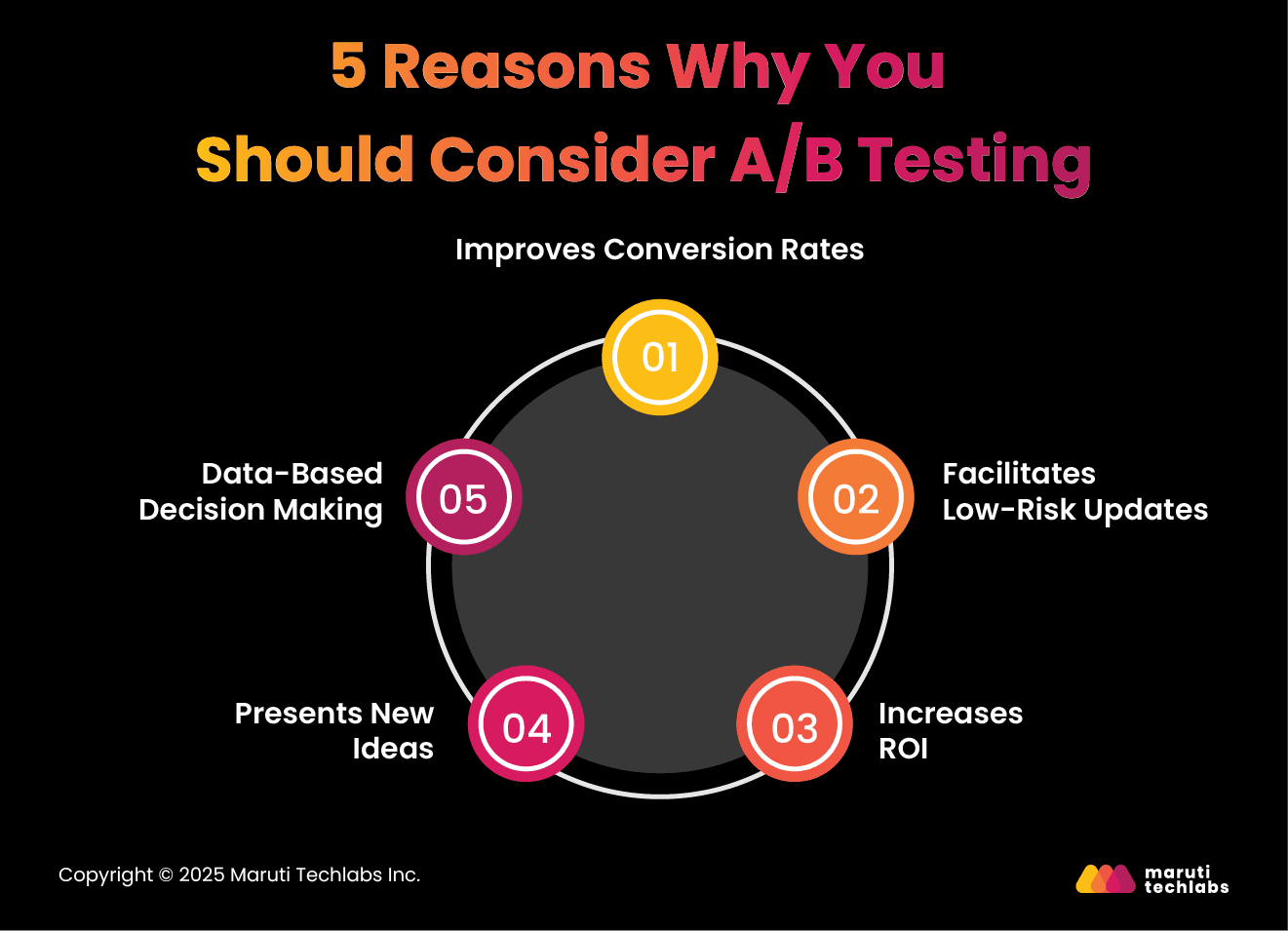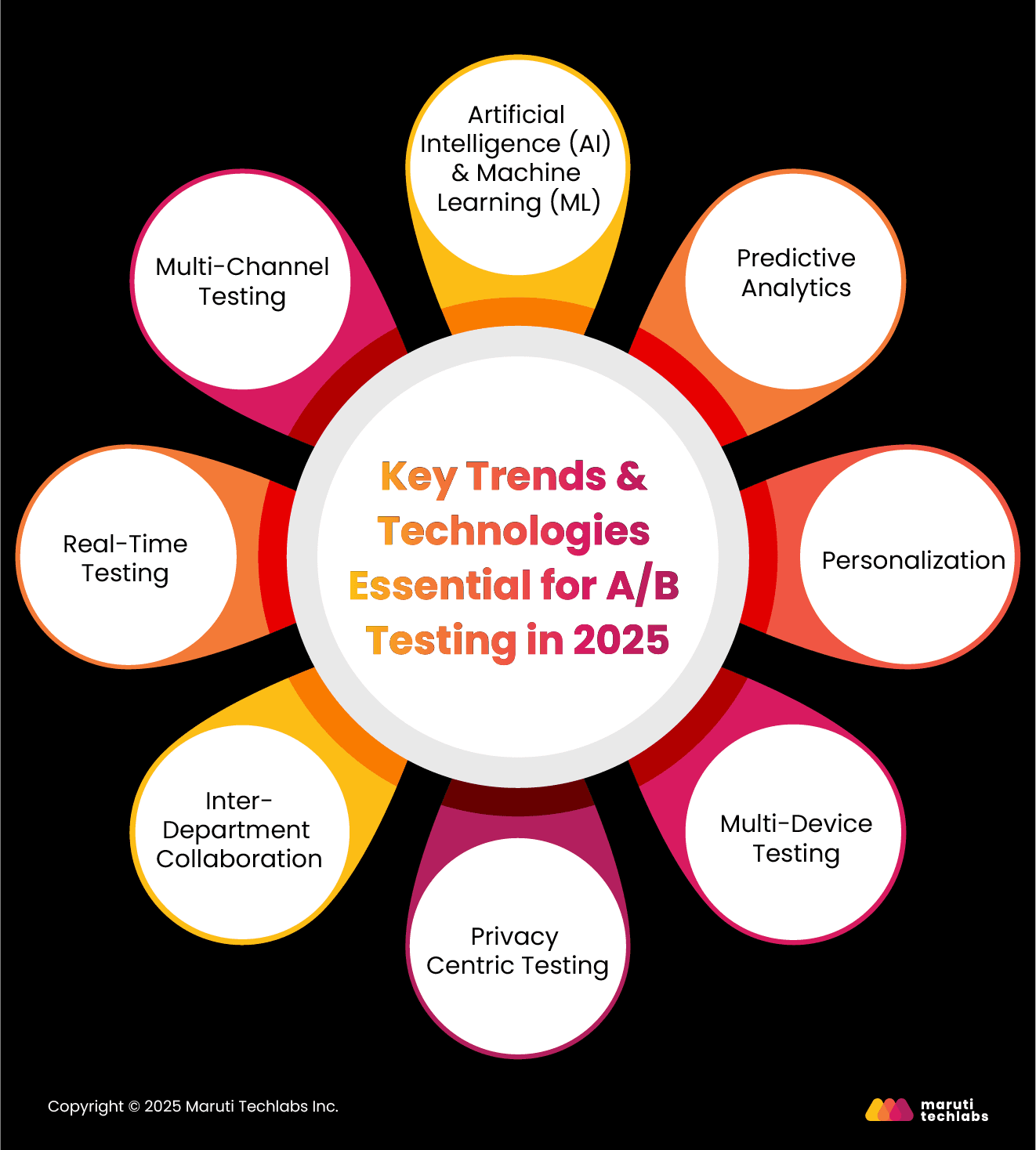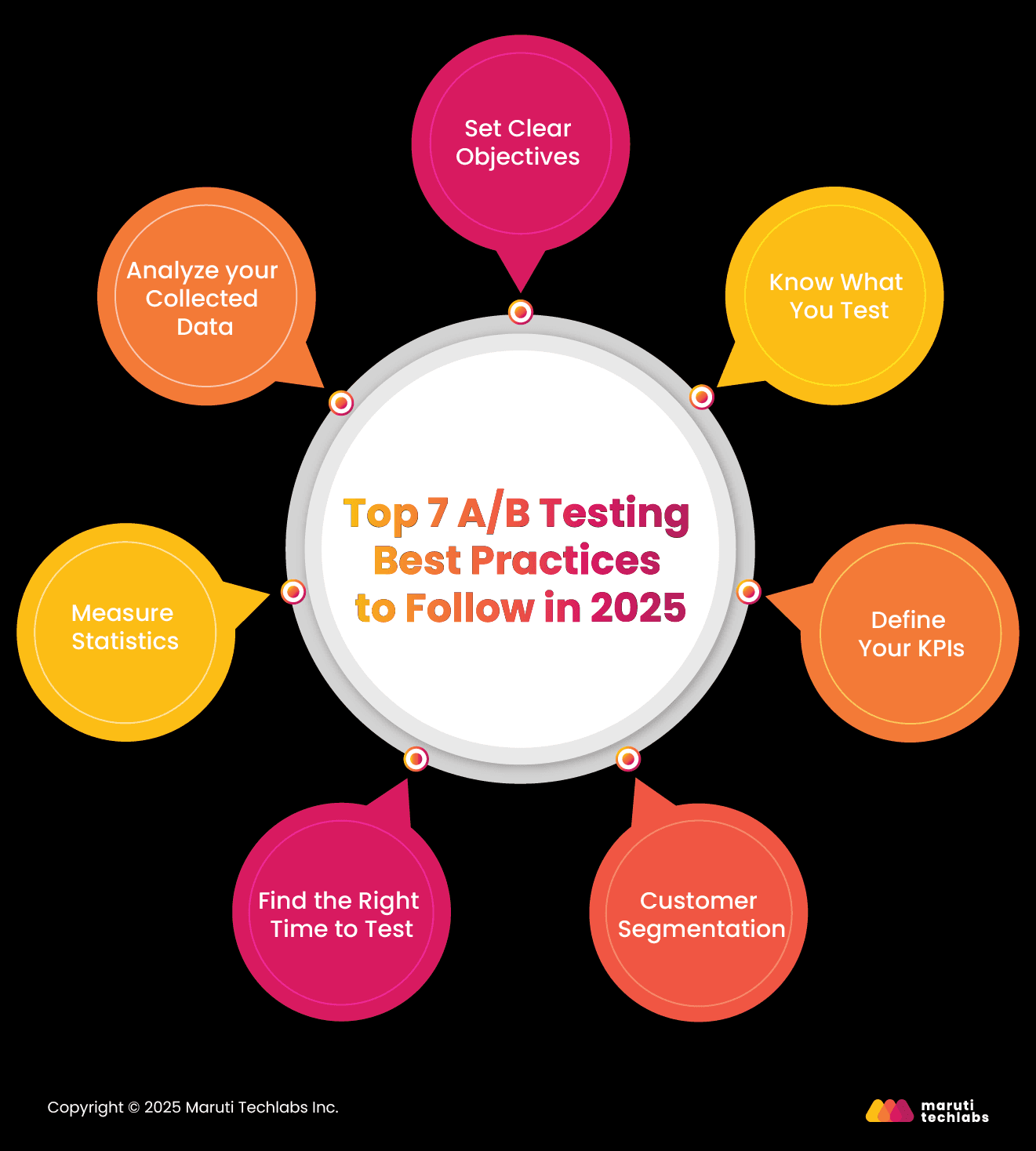

How to Establish Technology Frameworks for Faster A/B Testing?






Experimentation is the key to success when it comes to business strategies. One trend that has picked up pace in 2025 is A/B testing. According to a survey, about 77% of companies are experimenting with A/B testing on their websites, and more than 50% do it for their landing pages.
Some reasons for such a high adoption rate are enhanced user engagement, data-based decision-making, and increased conversion rates. Technology is a core contributor to how these tests are performed and why they become successful.
To offer you more insights on this subject, we bring you this blog, which dives deep into the importance, trends, tech, and best practices to perform a successful A/B test campaign in 2025.
Here are the top reasons why you should prioritize A/B testing.

Understanding effective strategies and implementing them can boost conversion rates. It helps determine pain points with our webpage or mobile app. In addition, it can convert potential customers to paying customers by improving your experience and allowing users to spend more time on your service.
A/B tests help experiment with small changes rather than changing entire pages. They also validate changes while ensuring maximum output.
A/B tests help present your resources while making minimal modifications, resulting in an increased ROI and insights into how different modifications improve performance metrics.
It gives your team the courage to try bold ideas that can be mapped statistically. Also, it’s a learning curve for the team as they know only successful ideas will be implemented.
A/B testing is an end-to-end data-driven process that leaves no room for guesswork. This helps companies make high-risk decisions based on solid experiment data.
A/B testing remains the bedrock when experimenting with optimization strategies. Learning the latest trends and technologies in A/B testing is essential in an era where experimentation is the key to success.
Here are the top 8 best practices and techs to enhance your next A/B testing campaign.

Machine learning and AI-based techniques can optimize the entire A/B testing process. AI equips the process with algorithms proficient at analyzing vast data, spotting patterns, and predicting user behavior.
Automated experiment design is one of the most inventive examples of using AI in A/B testing. Leveraging AI-powered tools makes discovering areas for improvement and analyzing website traffic a breeze.
For instance, if a button on your website isn’t receiving enough engagement, AI tools can locate it and suggest alternatives.
The ability to forecast future events makes predictive analysis an essential asset for A/B testing.
A/B testing creates two versions, ‘A’ and ‘B,’ of website elements like images, CTA buttons, or font styles and sizes. These versions are shown to different groups of users, and their performance is tracked. The statistically significant variant is chosen as the winner.
The advent of predictive analytics has revamped the A/B testing process, making it quicker and simpler. It shares insights even before the tests are concluded. In addition, marketers can exercise their efforts on their most promising content, minimizing waste and maximizing potential returns.
76% of customers agree that personalized messages enhance their decision-making when considering a brand. The introduction of AI exponentially increases the spectrum of possibilities. AI algorithms possess the power to learn user preferences and suggest relevant content.
Personalization isn’t limited to calling a user by their name or demographics. It can perform refined segmentation, i.e., bifurcating users based on different segments like preferences, demographics, and behavior.
This fosters hyper-personalized experiences and better-targeted A/B tests. Additionally, it allows you to design more impactful campaigns that enhance the conversion probability.
Today, A/B tests aren't confined to websites. They are conducted for mobile apps on multiple devices. 76% of US adults make purchases using a smartphone. A/B testing on mobile devices is used to devise engaging and seamless experiences congruent with modern users' on-the-go nature.
Whether modifying user interfaces or navigation, organizations today are inclined towards creating experiences that capture the nuances of mobile interactions. They aim to create applications that serve a smaller screen and design captivating experiences for users with devices in their palms.
Though this isn't a widely implemented practice, many companies are adapting privacy-centric testing, considering stringent regulations and privacy concerns. Organizations today realize the importance of privacy; however, they know what they can gain by conducting A/B testing in secure digital properties.
Companies can do this by letting users know how their data is used in experimentation. This simple step ensures regulatory compliance while maintaining trust between users and the company.
A/B testing is no longer a marketing experiment. In 2025, teams like customer support, UX design, and product development equally participate in the A/B testing process. This helps design a complete customer journey, integrating A/B tests into all the touch points in between.
Real-time testing will become a thing in 2025 due to the rising need for instant adaptability. It facilitates quick decision-making, learning user behavior, and quick feedback. In addition, it also enables faster iterations to observe optimal results by promptly adjusting campaigns and user experiences.
Multi-channel A/B testing is the need of the hour in 2025. Companies today cover all touchpoints, including social media, mobile apps, websites, and more. This helps develop a holistic approach to learning user interactions, offering consistency in experience across different channels.
When commencing your experimentation journey, begin with tests that offer immediate results to learn the effectiveness of your approach. The second step would be to learn the larger goal behind the next set of tests you choose.
This is to decide on the priority of marketing funnels you want to target. Having a clear idea of where you want the intended impact can help you plan tests that align with your goal.
The answers to these questions will help you justify your efforts to respective stakeholders while providing quantitative information about how they're enhancing your business.
Without a clear understanding & approach to the problem you're trying to address, you'll only be experimenting at random. Subsequently, you can waste time, money, and valuable resources.
Here's a checklist of 7 recommended practices to remember when creating your A/B testing framework.
Start with the basics: what do you want to achieve with your A/B tests?
Are you a recognized brand name amongst your potential customers? How much traffic does your website get? Are you looking for budget-friendly growth strategies?
More often than not, what you already know isn't working or is less performant than it should be is a good place to start. For instance, if you aren't meeting your MQL goals, you should try new pieces of free and gated content and observe what attracts your audience.
Keep your end goal in mind while listing what you wish to test.
For instance, you plan to A/B test your email campaigns. So, it's best to experiment with subject lines if you want to improve your open rates. However, if your goal is to increase the consumption of your gated content, your email's body and CTAs should reflect that.
Here are some elements you can experiment with in social media posts, websites, emails, or designs.
To learn the effectiveness of your test campaign, you'll have to know your current performance. Observe your metrics on MQLs, website traffic, paid campaigns, and more.
You must know where you began to get an exact idea of how you've improved. It's also suggested that you have industry benchmarks in mind to understand what works and what doesn't. Additionally, analyzing what your competitors attempt can also get you quicker results.
Here are a few metrics you can track to measure your campaign's success.

A/B tests can help understand the behavior of specific audiences. For example, you may want to try a feature with a particular buyer persona or exclude actual customers from potential customers for a paid ad campaign.
Here, you would need to segment customers. This can be done based on demographics (location, industry), behavioral data, or visitor sources (ads, organic search, and more).
We suggest using a customer's historical and behavioral data to create your audience's buyer persona. These data offer context on how users interact with your brand.
The result of your A/B tests is directly proportional to its timing.
Deciding on the perfect time can be a difficult feat to master. You don’t want to plan tests before a holiday when you don’t get expected results on user behavior. However, you don’t want to test during a slower business period.
Consider your goals when determining the time for your test; if the aim is to increase traffic on your early sale, testing around or before that time is advisable. But if your goal is to observe the impact of a UX change on everyday users, a sale isn’t the appropriate time to test.
One must have adequate statistics to compare tests A and B. You must integrate different tools necessary to note the numbers of your A/B tests.
This can help you decide on the proficiency level of your experiments and revamp various elements of your tests.
You've concluded your A/B tests and analyzed the results. Only experiments can help you understand what works and what doesn't. You can learn important lessons and customer insights even if they don't perform as expected.
However, collecting and understanding A/B test data isn't straightforward. You need all relevant statistical data to ensure no glitches or false positives with the collected data. The best approach is to leverage tools that assist you with testing and capturing results correctly.
A well-structured technology framework is essential for maximizing the benefits of A/B testing. By streamlining experimentation, it enables teams to test hypotheses quickly and iterate efficiently.
Improved data accuracy ensures reliable insights, leading to more informed decision-making. Additionally, a scalable framework supports growth, allowing businesses to run multiple tests simultaneously without compromising performance.
Are you still unsure how to commence your A/B testing journey? Don’t worry—we've got you covered.
14+ years of experience developing web and mobile applications makes us the perfect partner for conducting transparent and effective A/B tests. Our UI/UX service experts can guide you in understanding your current business performance, brainstorming new ideas, and creating an A/B testing roadmap that offers statistical adherence and strategic supremacy. Get in touch with us today and observe improvements in your businesses’ performance metrics within the first month.
An A/B testing framework is a structured system for designing, running, and analyzing experiments. It includes experiment setup, user segmentation, data collection, statistical analysis, and decision-making for optimizing performance.
The main types of A/B testing are:
Here are 7 steps to create your A/B testing framework
A/B testing methodology involves randomly splitting users into two groups (A and B), exposing them to different variations, measuring key performance metrics, and using statistical analysis to determine which version performs better.


